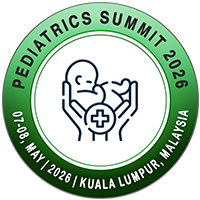
Gasanova Ella Nizamievna
Clinical and Research Institute of Emergency Pediatric Surgery and Trauma- Dr. Roshal’s Clinic (CRIEPST), Russian FederationPresentation Title:
Modern laser technologies in the treatment of vascular anomalies of the genitalia in boys
Abstract
Relevance: Vascular malformations of the male genitalia are exceedingly rare, with only isolated cases reported in the literature. There is a lack of medical studies that could establish clear treatment guidelines for vascular malformations of the genitalia. Preservation of fertility is a primary factor in selecting a treatment method, as well as the aesthetic component. Surgical excision and sclerotherapy are the main treatment options for vascular anomalies; however, they may be too aggressive for this anatomical region and carry significant recurrence risks. Currently, the most promising and effective method for treating various vascular anomalies is photodestruction using laser wavelengths that are selectively absorbed by hemoglobin in the vascular structures. This approach minimizes damage to surrounding tissues during the removal of pathological vascular structures and reduces the risk of recurrence.
Objective: To enhance the treatment method for boys with vascular anomalies of the external genitalia through the application of minimally invasive laser technologies to achieve a radical clinical and aesthetic outcome.
Materials and Methods: Over the past two years, five patients with vascular anomalies have presented to the Institute of Scientific and research Institute of emergency pediatric surgery and trauma - Roshal's Clinic. This cohort included one patient with a lymphatic malformation of the left testicular appendage, two patients with venous malformations of the scrotum, one patient with a venous malformation of the glans penis, and one patient with a hemangioma of the scrotum. The diagnosis was put after examination with ultrasound and Dopplerography and with contract-enhanced magnetic resonance tomography. No additional vascular anomalies were identified during the examinations. Surgical procedures were performed using laser photodestruction under general anesthesia. Laser surgical device LSP "IRE-Polus" with two wavelengths 0.97 µm and 1.56 µm (Russia) was used. Outcomes of the treatment were assessed at ultrasound and Dopplerography examination on days 7, 30, 90 and one year after the surgery.
Results: All pathological vascular structures were precisely excised, reliable hemostasis was achieved, and thermal damage to surrounding tissues was minimized. These factors collectively contributed to favorable clinical and aesthetic outcomes, effectively eliminating the risk of recurrence. Furthermore, the minimally invasive nature of laser treatment facilitated faster recovery for patients and reduced the need for additional anesthesia, which is particularly significant in pediatric practice.
Conclusion: The results of treating vascular anomalies of the external genitalia in boys underscore the promising application of laser photodestruction in the clinical practice of pediatric surgery, urology, and andrology, opening new avenues for the effective management of these pathologies.
Biography
Ella Gasanova graduated from Pirogov Russian State Medical University. She completed her residency in pediatric surgery at the Clinical and Research Institute of Emergency Pediatric Surgery and Trauma in Moscow. Following this, she specialized in pediatric urology-andrology and laser technologies for treating vascular pathologies in children. Since the beginning of her career, she has treated children with vascular pathologies and various congenital anomalies of the external genitalia. She is actively involved in research in this field, has authored 36 publications, and holds a patent for an invention. In 2024, Dr. Gasanova defended her PhD thesis on the effectiveness of combined laser photodetection in the treatment of pyogenic granulomas in children. She is currently the head of the Department of Laser Surgery.

